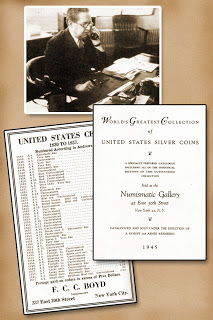
‘Players’
1. John J. Ford, Jr.
2. William H. Woodin
3. B. Max Mehl
4. Charles E. Barber
5. George Heath.
‘Bases’
A. Working as a clerk in a shoe store in Texas, he dreamed of better opportunities, and beginning in 1900 became a part-time coin dealer. In 1903 he ran his first ad in The Numismatist. Fame and fortune became his, and by the time of his passing in 1957 he was recognized as America’s most famous rare coin dealer. At one time, in the 1930s, he even had his own nationwide radio program.
B. Working as an aerial photographer, he survived a plane crash. At another time, in 1955, a drunken bidder in one of his auction sales tried to push him off a rooftop parapet into the street below. In the 1970s he enjoyed driving his Lincoln Continental. His ‘Numismatica Americana’ column was published briefly in The Numismatist and still makes good reading today.
C. An industrialist of nationwide importance, he enjoyed numismatics as a hobby. In the early 20th century he specialized in gold coins, hoping to publish a study on half eagles. He loved music as well, and the Berlin Philharmonic Orchestra performed one of the five symphonies he wrote, Oriental Suite. In 1933 he was President Franklin D. Roosevelt’s first secretary of the Treasury.
D. This gentleman, a medical doctor, enjoyed taking long train trips and writing about them. At one time he was mayor of Monroe, Michigan. Today, he is best remembered as founder of The Numismatist.
E. Sculptor Augustus Saint-Gaudens said the medal engraving work of this man, chief engraver at the Mint, was ‘wretched.’ On the other hand, certain of his work was certainly memorable, such as the 1883 Liberty Head nickel.
–
Answers: 1-B, 2-C, 3-A, 4-E, 5-D





